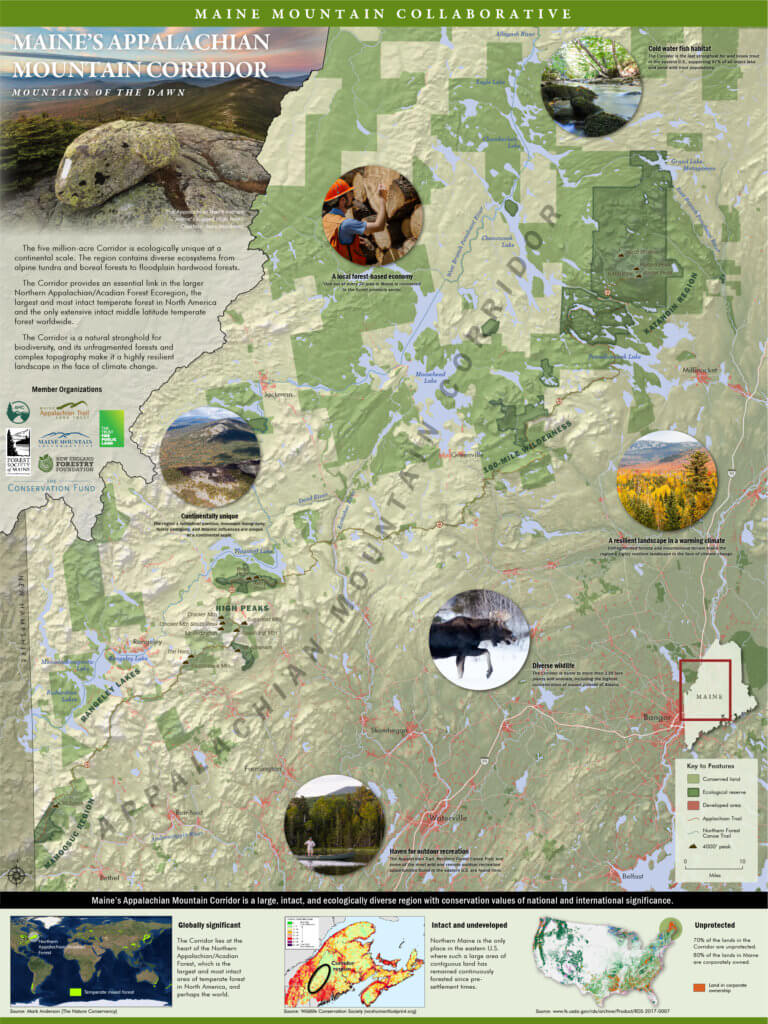The most important thing about the Northern Forest Canoe Trail may not the trail itself but the landscape through which it traverses. The entire region is an American gem, and the NFCT not only connects us to the landscape but helps tell its story. About half of the trail – 347 miles – is in Maine, and most of that through what some now call the Maine Appalachian Mountain Corridor.
Maine’s Appalachian Mountain Corridor is a nationally significant area encompassing roughly 5 million acres of remote mountains and unbroken Acadian forest (unique to the Northeastern U.S. and Maritime Canada) that extends from the White Mountains to Katahdin and beyond. It is part of the largest undeveloped, intact forest east of the Mississippi and the largest area of temperate forest in North America, and perhaps the world.
In 2014 land conservation groups started to focus on this region and develop new ways to approach land conservation here. Now known as the Maine Mountain Collaborative, we produced this short video to introduce others to the region:
A recent report by Janet McMahon (2016) documents the ecological significance of the area including:
- All of Maine’s high mountain peaks;
- Over half of the largest globally significant bird area in the U.S.;
- Twenty-one globally rare species and many others found only in the Northern Appalachians;
- Essential habitat responsible for the last remaining U.S. stronghold for wild brook trout; and
- Core habitat providing the greatest remaining opportunity in eastern North America for maintaining lynx populations.
- The headwaters of the major rivers of Maine,
- A critical ecological linkage for plant and wildlife to help species adapt to climate change.
The Maine Mountain Collaborative includes the Appalachian Mountain Club, Forest Society of Maine, Maine AT Land Trust, The Mountain Conservancy, New England Forestry Foundation, Trust for Public Land, and The Conservation Fund. The Nature Conservancy and the Wilderness Society have played critical supporting roles especially in ecological prioritization.
The groups began by asking what could be achieved collectively to raise awareness of the region and innovate new financial strategies to accelerate the pace and scale of forest conservation and restoration. This was in response to four critical factors:
- Large timber investment owners and others were likely to be selling significant tracts of land in the next five years.
- Federal and state land conservation funding in New England has declined by 50 percent since 2008.
- New research and mapping by TNC and others pointed to the Maine Mountain region as a nationally-important landscape for climate resiliency and biodiversity.
- Short-term timber ownership patterns were driving harvesting practices that have led to an overall decline in forest stocking and forest stand distributions that do not align with the habitat needs of Maine wildlife – most notably the loss of older stands of forests.
Together the members of the Collaborative are working together to:
- Bring attention to the region’s national ecological significance.
- Highlight its critical role as a wildlife corridor now and as the climate changes.
- Communicate the region’s exceptional recreational, economic and cultural importance.
- Identify critical parcels and conserve both well-managed forests and ecological reserves to provide landscape-level connectivity and support communities.
- Increase philanthropic support and conservation-minded investment through traditional and innovative approaches.
To find out more see the website:
http://mainemountaincollaborative.org/
Or contact me at bwentzell@mainemountaincollaborative.org
